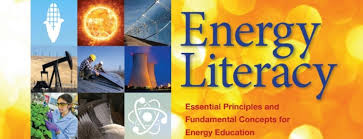 It may be possible to teach about energy without ever digging into the dynamics of human-caused climate change. (Quick note: I don’t endorse that tack, but it’s possible.) Indeed, many energy education programs sidestep or avoid climate change altogether. It’s easy to see, for example, how a heated discussion about the implications of continued fossil fuel use could easily distract from investigating the formation of fossil fuels and the physics and chemistry involved with their extraction, refinement, and combustion.
It may be possible to teach about energy without ever digging into the dynamics of human-caused climate change. (Quick note: I don’t endorse that tack, but it’s possible.) Indeed, many energy education programs sidestep or avoid climate change altogether. It’s easy to see, for example, how a heated discussion about the implications of continued fossil fuel use could easily distract from investigating the formation of fossil fuels and the physics and chemistry involved with their extraction, refinement, and combustion.
But it is impossible to teach about climate change without at least touching on the role of fossil fuels in generating energy and contributing to the heating of the planet. Climate and energy are intrinsically wed and they affect every living thing on the planet. Teaching these topics with an integrated approach transforms them into a complementary and dynamic duo, capable of fostering knowledge and informed decision-making.
Chapter 5 of Climate Smart & Energy Wise deconstructs the elements of the Energy Literacy Framework, developed under the leadership of the US Department of Energy and modeled primarily on the Climate Literacy Framework. Whereas the previous chapter unpacked the seven essential principles for climate literacy, this one unpacks the seven essential principles of energy literacy, summarized below:
1. Energy is a physical quantity that follows precise natural laws.
2. Physical processes on Earth are the result of energy flow through the Earth system.
3. Biological processes depend on energy flow through the Earth system.
4. Various sources of energy can be used to power human activities, and often this energy must be transferred from source to destination.
5. Energy decisions are influenced by economic, political, environmental, and social factors.
6. The amount of energy used by human society depends on many factors.
7. The quality of life of individuals and societies is affected by energy choices.
The chapter also showcaes online resources recommended by the CLEAN collection, offering suggestions on “Doing the Math” to help students develop a sense of numeracy—a goal of the Common Core curriculum.
Where climate, if it is covered at all, has been traditionally relegated to geography or Earth science classes, energy has often been touched on in piecemeal fashion within various courses of a typical science curriculum. For example, biology courses typically cover how solar energy drives the food web through photosynthesis and how fossil fuels are part of the global carbon cycle; different sources of energy are usually discussed as part of physics classes.
This hither-and-yon coverage of energy is not surprising, since the topic clearly crosscuts the sciences. However, it is important to maintain connectivity, continuity, and a narrative thread to help build understanding, which is why the Next Generation Science Standards emphasize energy and matter (and the relationship between them) as a crosscutting concept.
As laid out in the Next Generation Science Standards, foundational understanding of energy should begin in elementary school, with fourth grade being a crucial foundational stage in pedagogical development, where learners can start to really connect the dots of energy in their lives.
Alas, as a resent survey found, science in elementary school is often limited to a smattering of instruction a few days a week if not missing all together. And few elementary teachers have strong content background or confidence in teaching science, especially complex topics like climate and energy. The result: the foundation for tackling climate and energy topics in middle and high school is not there.
Ideally, in middle and high school, exploration of energy in ecosystems, climate systems, and in our lives deepens, as students explore ways of minimizing negative impacts of our energy-intensive lifestyles, but also recognize the connections between photosynthesis, the carbon cycle, fossil fuels, and the heating of the planet through increased concentrations of greenhouse gases.
(One of NGSS’s flaws is that, while greenhouse gases are included, the greenhouse effect is not, but I point to some of the online resources from CLEAN like this one, that can help students understand how these gases trap heat and thereby alter the planet’s energy dynamic.)
Energy will always be a core component of traditional physical science and physics education. But making it come alive in life, physical, and Earth sciences can help to add social and scientific context. Fortunately, the CLEAN collection has numerous resources and teaching tips that can help integrate energy into these courses.
But the Energy Literacy Framework not only spans traditional silos within science; it suggests integration outside of the science classroom, too. The fourth principle, for example, is technology and engineering focused, the fifth and sixth bring in issues of civics and social studies, and the seventh focuses on quality of life and values.
All of this points to the imperative of teaching climate and energy throughout the curriculum. Combined together, these topics offer ideal interdisciplinary, integrating themes that are inherently problem-based, requiring solutions and responses at every level of society.
